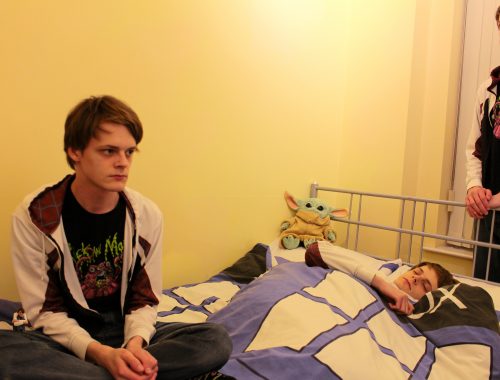
Assumption – the Parent of Confusion
A reflection on my initial work placement experience
Today’s creative arts industry has never been more crowded and competitive. In order to personally progress within the workplace and gain a successful shot at working in a professional creative environment, it is crucial to go the extra mile and take every single opportunity that comes your way. Students like myself, who study subjects within the arts sector will know that today’s employers don’t just look for someone who can, but also for someone who is willing, passionate and determined. This is something I learned first-hand when I began my search for work placement before the start of the academic year.
Securing a position at the EnterYes Studio in Belfast in a sense, dates back to 2019, when I was approached by Don, a university lecturer who was looking for students interested in sound design work for a local animation project. At the time, I seen this purely as an opportunity to build my CV due to it being unpaid work, however in the long term, turned out to be an even more worthwhile project to be involved in.
Angela Myles Beeching, in her book “Beyond Talent”[1] talks about networking and the correct mindset to get work referral from your social circle and beyond, stating, “Sometimes you might think – what if I don’t know anybody who can refer work to me? Well actually, you DO. These can be current and former teachers, coaches, family and friends. But in order for these people to refer work to you, they need to know what you’re looking for and what you have to offer.”
The final line from this reading applied accurately to myself in the months following, after I had worked on 3 projects in total with EnterYes, all of which had received a wide and positive reception, and with Don’s help and referral, I was able to directly get in contact with the studio manager Vicki and secure my work placement as my employer was already aware of what I had to offer and what I was capable of when working on particular projects.
Throughout this blog, I will be using the Gibbs Reflective Cycle Model[2] to analyse and consider my initial experience of the work placement through 6 different stages.

Description, Thoughts and Feelings
My placement began on Monday the 19th of October, at the EnterYes Studio in Belfast, Cathedral Quarter. After being given directions to the location of the studio, I made my way up and was greeted by Carla, the team leader who oversees the studio when the manager is absent. Upon entering the main computer suite, I noticed all the employees were working quietly by themselves, and so as I was walked over to my own workstation, I felt a little awkward and almost intrusive, trying not to disturb anyone’s work. Before starting the placement, I had told myself that my main focus throughout the experience would be networking and improving my team working skills, therefore I knew the first thing I had to do was to introduce myself to the fellow colleagues and shadow them in their roles to gain an understanding of what their daily tasks consisted of. Scharf and Wilson[3] state that “early emersion in the work world gives students a chance to identify which skills are needed for particular work roles, allowing the student to realistically define a personal strategy for acquiring needed skills”.
Based off this initial event, I had defined a personal strategy to ensure my employer was confident in my social skills and knew I was capable of adapting within any given circumstance by being the first to offer help and showing interest in the projects the team was working on.
Later that day, I was given a new animation to complete sound design for, however due to my university timetable, my placement schedule consists of only 4 hours, 2 days a week, somewhat limiting my time in the studio. I spent almost the rest of my day waiting for the animation files to be downloaded and imported, which was quite frustrating as I had expected there to be a computer within the studio for me to use without the hassle of transferring several files onto my own laptop.
Evaluation
In a sense, when analysing the situation, I became aware that what I had assumed and expected from the initial work placement experience was complete contrary to reality. The studio consists of a very small team, and is run independently in a small office building, something I personally never imagined for one reason or another. Despite some frustrations, such as not being fully integrated into the team or conceivably wasting time on tribulations which could have been avoided, I did learn that preparation and self-awareness is an essential part of interaction skills within the workplace, and that one must be mindful of their fears, wishes and starting points to see how they can potentially affect communication. Additionally, I personally believe I greatly enhanced my employability by developing my adaptability skills and ways to handle pressured situations in a professional manner by finding quicker ways to begin the tasks that were needed to be done.
Conclusion and Action Plan
Concluding, my first thoughts are always what else could I have done, or what could have been done better. Preparation seemed to be the biggest concern throughout my initial experience, therefore in the future, I will know the importance of communication before and on arrival in the workplace in order to make the experience not only as smooth as possible but also avoid unnecessary stress for anyone involved. In this case, something as simple as emailing the manager the day before to ask what equipment there is on site, and what I need to bring could have significantly changed the course of the day. My action plan for future days at the studio will be to gain a clear and thorough understanding of the tasks that will be given and exactly what is needed to complete the job efficiently and to an excellent standard.
References
[1] Beeching, A.M. Beyond talent: creating a successful career in musicLinks to an external site.. Oxford & New York: Oxford University Press (2005)
[2] Gibbs, G. (1998) Learning by Doing: A Guide to Teaching and Learning Methods. Oxford Brooks University, Oxford.
[3] Scharf, Peter, and Thomas Wilson. “Work Experience: A Redefinition.” Theory Into Practice 15, no. 3 (1976)
Back to School (Again?)

First Day Fears
You May Also Like

First Day Fears
24 November 2021
Facing Avoidance
26 November 2021
